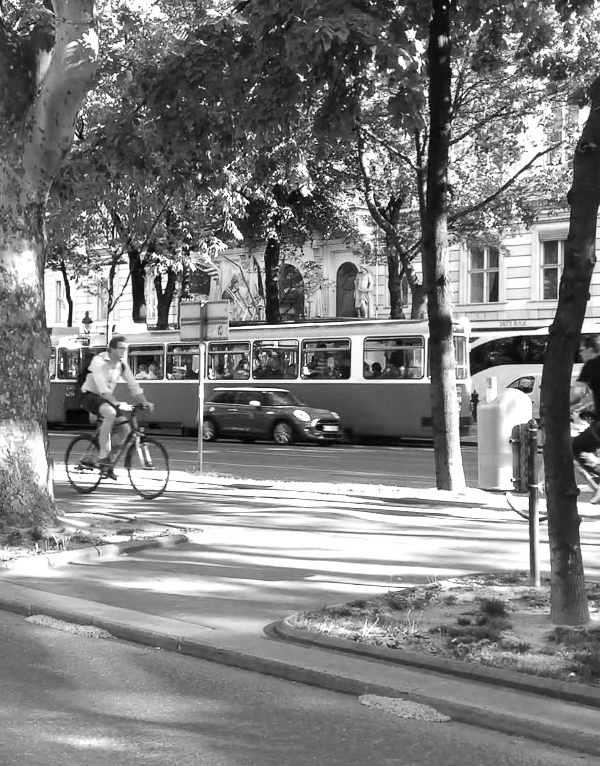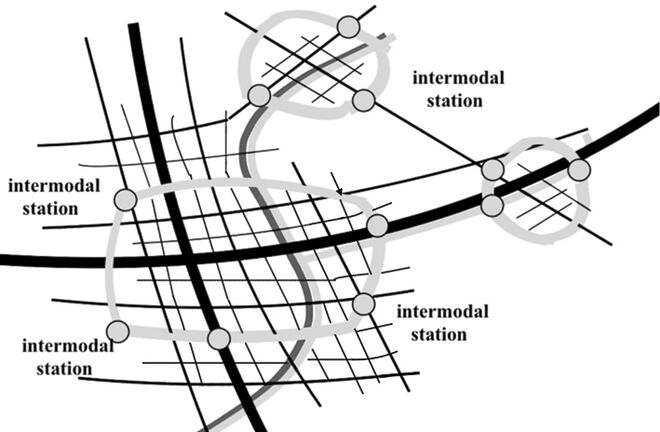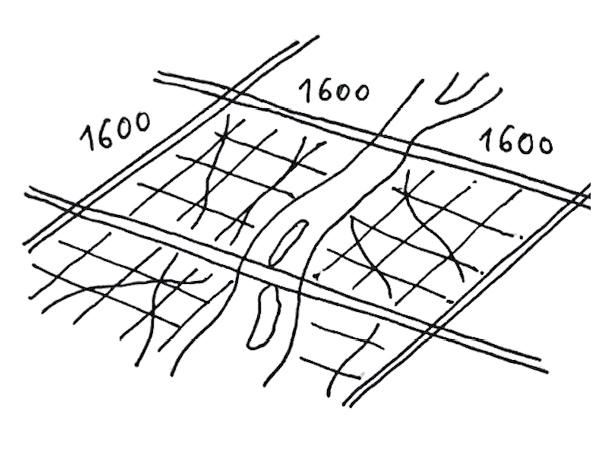3.1. Urban Greenway
Aus Pattern Language Wiki
(Weitergeleitet von .../Urban Greenway)
Within the Polycentric Region, provide functional and beautiful pathways for transportation and ecology.
Problem-statement: People need human-scaled pathways around their city that offer many different modes of travel including walking and cycling, that are beautiful, ecological and functional, and that link with other modes of travel.
Discussion:: Mobility corridors are focused on high-speed inter-urban mobility for vehicles, but they leave out the lower-speed forms of travel for more routine urban trips. The pattern of the urban greenway described here combines generous lanes for walking, biking, surface trams, moderate-speed surface vehicles, and below-grade trains, all linked by periodic intermodal stations. It is thus convenient to travel along an urban greenway corridor to intersect other train stations and transit lines within the region and beyond.
A polycentric region with several urban greenway loops.
Urban greenways can be laid out, in some cases, along existing stream and river corridors to maintain ecological corridors for natural vegetation and wildlife, taking care to protect ecologically sensitive features — for example, placing the more disruptive pathways along the banks above stream corridors.¹ Urban greenways can also be developed out of previous beltways, such as the Ringstrasse in Vienna — seen in the photo at the beginning of this pattern — which was redeveloped from the beltway formed by the old city wall.
Care must be taken to lay out greenways to optimize both pedestrian safety and ecological viability, which can be difficult. However, a number of investigations have begun to establish strategies and approaches to do so.²
Care must be taken to lay out greenways to optimize both pedestrian safety and ecological viability, which can be difficult. However, a number of investigations have begun to establish strategies and approaches to do so.²
The philosophical basis for this pattern is shared by the pattern Blue-Green Network — namely, that we can creatively combine distinct systems of networks, including ecological and transportation networks. Some networks work relatively well parallel to each other (e.g. walking, biking, trams) whereas others have to cross, with careful control at their intersections (e.g. a bridge over a river or creek).
Therefore:
Within the rough 400-meter grid pattern, lay out an urban greenway corridor system at a roughly 1600 meter (1 mile) spacing. Assure that the corridors connect to key nodes of transportation and intermodal travel.
Run each urban greenway adjacent to a Pedestrian Sanctuary that provides housing and other uses.
¹ See for example the greenway corridor system in Singapore, considered a model for other Asian and international cities: Tan, K. W. (2006). A greenway network for Singapore. Landscape and Urban Planning, 76(1-4), 45-66. Available on the Web at http://faratarjome.ir/u/media/shopping_files/store-EN-1458113022-7947.pdf
² See for example Luymes, D. T., & Tamminga, K. (1995). Integrating public safety and use into planning urban greenways. Landscape and Urban Planning, 33(1-3), 391-400.
Mehaffy, M. et al. (2020). URBAN GREENWAY (pattern). In A New Pattern Language for Growing Regions. The Dalles: Sustasis Press. Available at https://pattern-language.wiki/.../Urban_Greenway
SECTION I:
PATTERNS OF SCALE
1. REGIONAL PATTERNS
Define the large-scale spatial organization…
1.4. 400M THROUGH STREET NETWORK
2. URBAN PATTERNS
Establish essential urban characteristics…
3. STREET PATTERNS
Identify and allocate street types…
4. NEIGHBORHOOD PATTERNS
Define neighborhood-scale elements…
5. SPECIAL USE PATTERNS
Integrate unique urban elements with care…
6. PUBLIC SPACE PATTERNS
Establish the character of the crucial public realm…
7. BLOCK AND PLOT PATTERNS
Lay out the detailed structure of property lines…
8. STREETSCAPE PATTERNS
Configure the street as a welcoming place…
9. BUILDING PATTERNS
Lay out appropriate urban buildings…
10. BUILDING EDGE PATTERNS
Create interior and exterior connectivity…
10.1. INDOOR-OUTDOOR AMBIGUITY
SECTION II:
PATTERNS OF MULTIPLE SCALE
11. GEOMETRIC PATTERNS
Build in coherent geometries at all scales…
11.2. SMALL GROUPS OF ELEMENTS
12. AFFORDANCE PATTERNS
Build in user capacity to shape the environment…
13. RETROFIT PATTERNS
Revitalize and improve existing urban assets …
14. INFORMAL GROWTH PATTERNS
Accommodate “bottom-up” urban growth…
15. CONSTRUCTION PATTERNS
Use the building process to enrich the result…
SECTION III:
PATTERNS OF PROCESS
16. IMPLEMENTATION TOOL PATTERNS
Use tools to achieve successful results…
16.2. ENTITLEMENT STREAMLINING
16.3. NEIGHBORHOOD PLANNING CENTER
17. PROJECT ECONOMICS PATTERNS
Create flows of money that support urban quality…
17.4. ECONOMIES OF PLACE AND DIFFERENTIATION
18. PLACE GOVERNANCE PATTERNS
Processes for making and managing places…
18.3. PUBLIC-PRIVATE PLACE MANAGEMENT
19. AFFORDABILITY PATTERNS
Build in affordability for all incomes…
19.1. INTEGRATED AFFORDABILITY
20. NEW TECHNOLOGY PATTERNS
Integrate new systems without damaging old ones…
20.2. RESPONSIVE TRANSPORTATION NETWORK COMPANY


